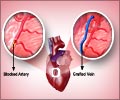
These registry findings, derived from the largest ever study population of triple vessel disease patients with SYNTAX score assessment, are consistent with those found in the SYNTAX randomised trial. However, said Dr Shiomi, while the observations were striking in patients with triple vessel disease, the selection of revascularisation strategies in patients with less complex coronary anatomy "deserves further consideration".
As background to the report, he explained that PCI has been widely performed in patients with severe coronary disease (such as left main or triple vessel coronary artery disease) following the introduction of drug-eluting stents. However, long-term clinical outcomes of PCI relative to CABG in such patients have not yet been adequately evaluated. Although three-year results from the SYNTAX trial suggested that an excess risk of PCI relative to CABG for death, myocardial infarction or stroke was significant in the triple vessel disease subset, there were limitations in the apparent lack of statistical power to evaluate this composite endpoint.
The CREDO-Kyoto (Coronary REvascularization Demonstrating Outcome Study in Kyoto) PCI/CABG registry cohort-2 is a physician-initiated non-company sponsored 26-centre registry enrolling consecutive patients having a first coronary revascularisation between January 2005 and December 2007. The study population for the current analysis consisted of 2981 patients with triple vessel disease (PCI 1825 patients, and CABG 1156 patients). To ensure comparability between the PCI and CABG groups (in an observational study), anatomic complexities of coronary artery disease were assessed by using the SYNTAX score.
The primary endpoint of the study was a composite of all-cause death, myocardial infarction (MI) and stroke. PCI as compared with CABG was associated with a higher 3-year risk for this primary endpoint (adjusted hazard ratio (HR) 1.47 [95% CI 1.13-1.92, P=0.004]) and for MI (HR 2.39 [95% CI 1.31-4.36, P=0.004]). However, the risk for cardiac death was not significantly different (HR 1.30 [95% CI 0.81-2.07, P=0.28]), although the risk for all-cause death was significantly higher after PCI (HR 1.62 [95% CI 1.16-2.27, P=0.005]).
Results also showed that the cumulative incidence of the primary endpoint was comparable between the PCI and CABG groups in patients with low (<23) and intermediate (23-32) SYNTAX scores, but in patients with high SYNTAX scores (≥33) was markedly higher after PCI than after CABG (15.8% and 12.5%, P=0.25, 18.8% and 16.7%, P=0.24, and 27.0% and 16.4%, P=0.004, respectively).
Advertisement
Advertisement










